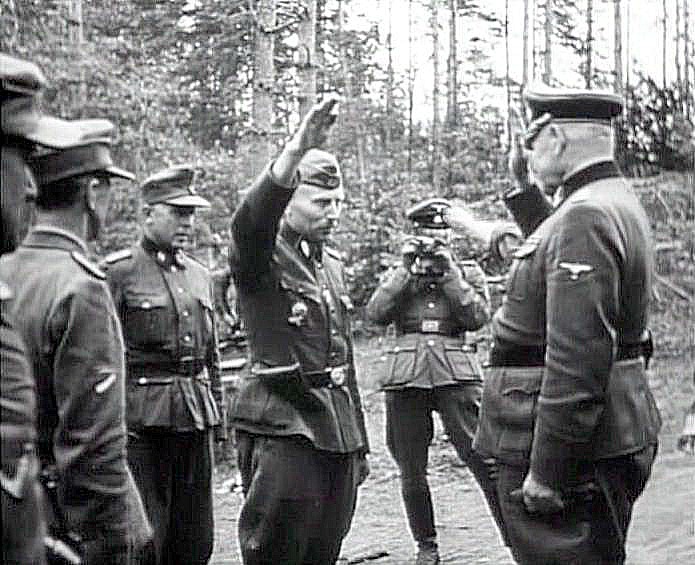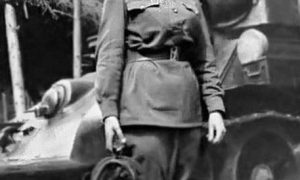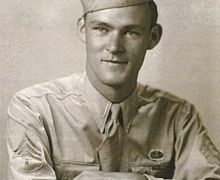The Latvian SS Volunteer Legion (Latvian Latviešu SS brīvprātīgo leģions, German Lettische SS-Freiwilligen-Legion)is a national military formation created by the German command during World War II in the territory of Latvia. This unit was part of the SS troops and was formed from two SS divisions: the 15th Grenadier and the 19th Grenadier.
What was the Latvian SS Volunteer Legion?
Background
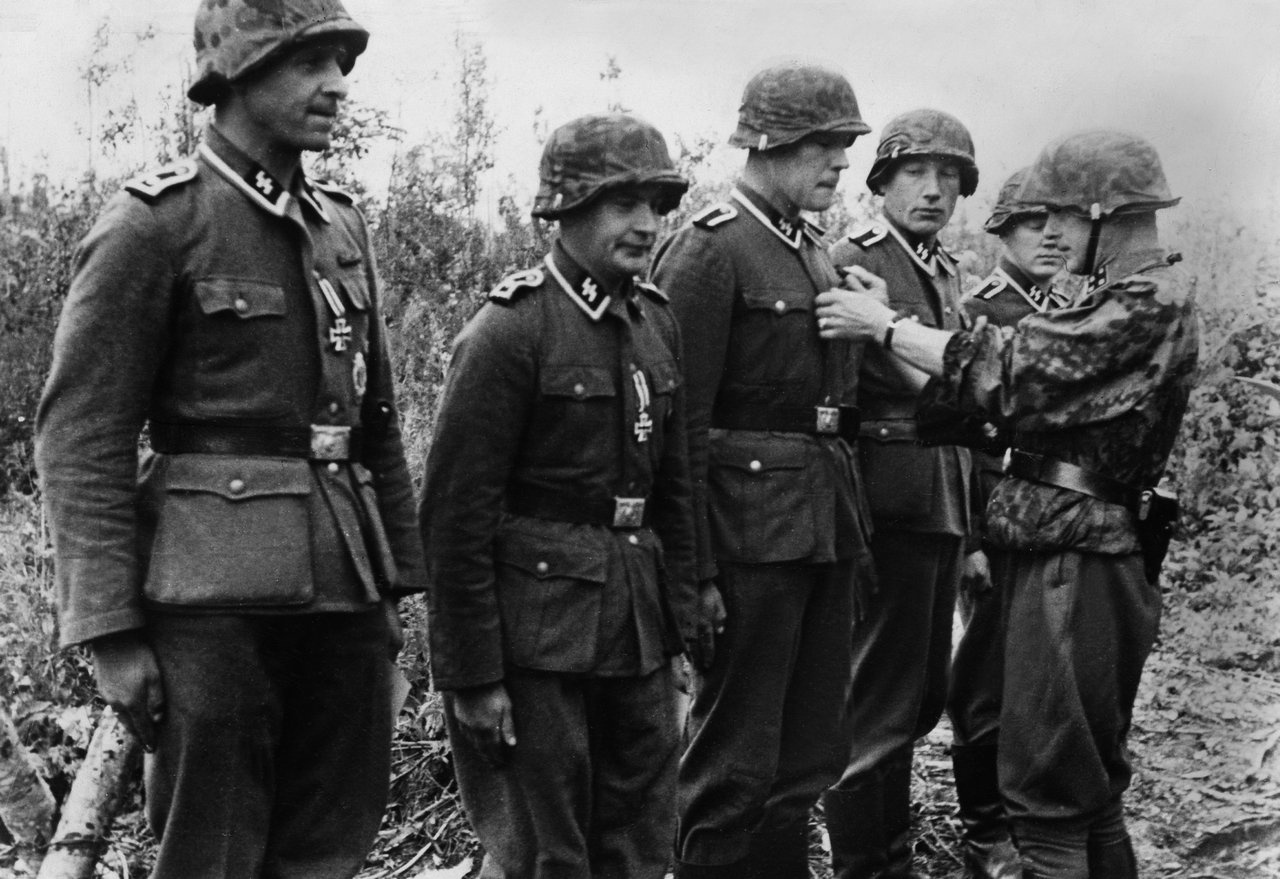 After the occupation of the western regions of the USSR, a guerrilla war began in the rear of the Nazis, which influenced Hitler’s decision to allow the previously unplanned creation of national armed formations from among the inhabitants of the occupied territory of the USSR. On August 25, 1941, Field Marshal von Leeb, Commander of Army Group North, officially authorized the recruitment of Lithuanians, Estonians and Latvians and the creation of special teams and volunteer battalions from them. In the autumn of 1941, regular police battalions began to form in Latvia on the basis of “self-defense units”.who were entrusted with punitive operations. In October 1941, the first Latvian battalion was sent to fight partisans in the Pskov region, and in December of the same year, the Latvian police took part in punitive actions on the territory of Belarus. In the Caucasus in the summer of 1942, in the rear of the German troops, the 18th and 27th Latvian police battalions “put things in order”.
After the occupation of the western regions of the USSR, a guerrilla war began in the rear of the Nazis, which influenced Hitler’s decision to allow the previously unplanned creation of national armed formations from among the inhabitants of the occupied territory of the USSR. On August 25, 1941, Field Marshal von Leeb, Commander of Army Group North, officially authorized the recruitment of Lithuanians, Estonians and Latvians and the creation of special teams and volunteer battalions from them. In the autumn of 1941, regular police battalions began to form in Latvia on the basis of “self-defense units”.who were entrusted with punitive operations. In October 1941, the first Latvian battalion was sent to fight partisans in the Pskov region, and in December of the same year, the Latvian police took part in punitive actions on the territory of Belarus. In the Caucasus in the summer of 1942, in the rear of the German troops, the 18th and 27th Latvian police battalions “put things in order”.
In total, during the years of the Great Patriotic War, 41 such battalions were formed in Latvia (for comparison: in Lithuania – 23, and in Estonia – 26), an average of 300 people.
In 1942, the Latvian civil administration, in order to help the Wehrmacht, offered the German side to create on a volunteer basis armed forces with a total strength of 100 thousand people, with the condition that Latvia’s independence be recognized after the end of the war. Hitler rejected this offer.
After the losses suffered by the German army after the winter (1941-1942) counter-offensive of the Red Army near Moscow, Hitler was forced to transfer the “national” police units to the German military command as a reserve for combat operations and the fight against partisans.
In February 1942, on the basis of the 16th, 19th, 21st and 24th Latvian battalions, the 2nd SS motorized brigade (2.SS-Infantereie-Brigade (mot)) was created. In the fall of 1942, it was transferred to the Eastern Front near Leningrad.
On January 24, 1943, SS Reichsführer Heinrich Himmler, during a trip to the Eastern Front, on the basis of Hitler’s oral “permission and command”, ordered the 19th and 21st Latvian police battalions that fought near Leningrad to be united as part of the 2nd SS motorized brigade, giving them the name “Latvian SS Volunteer Legion”.
In November 1943, the 2nd Latvian SS Volunteer Brigade was created from the 39th and 40th Latvian volunteer regiments. She participated in combat operations against Red Army units from November 1943 to January 18, 1944 in various sectors of Army Group North.
.
The growing need for manpower forced the Nazi leadership to change their attitude towards participation in the war of the Baltic peoples. In 1943, the German occupation institutions agreed to return the property nationalized under Soviet rule to the inhabitants of Latvia, but put forward a demand for the entry of Latvians into the SS legion being created. Publicist Juris Paiders considers this a deal with the Latvian elite: property in exchange for consent to grind tens of thousands of young men of a simple class in the millstones of war. The Latvian elite, unlike the Lithuanian one, showed that for them the return of property is more important than the return of statehood. There were only a few speeches against this deal: for example, the former minister of the government of K. Ulmanis, and in 1943, at the initial stage of the creation of the Latvian self-government, its general director Alfred Valdmanis said: “We wanted to fight honestly for our people, our state, our land, for place of his people in Europe. In addition, we wanted to fight not as hired “guardians of order”, but as honest soldiers”. However, these performances were quickly suppressed.
Mobilization into the legion
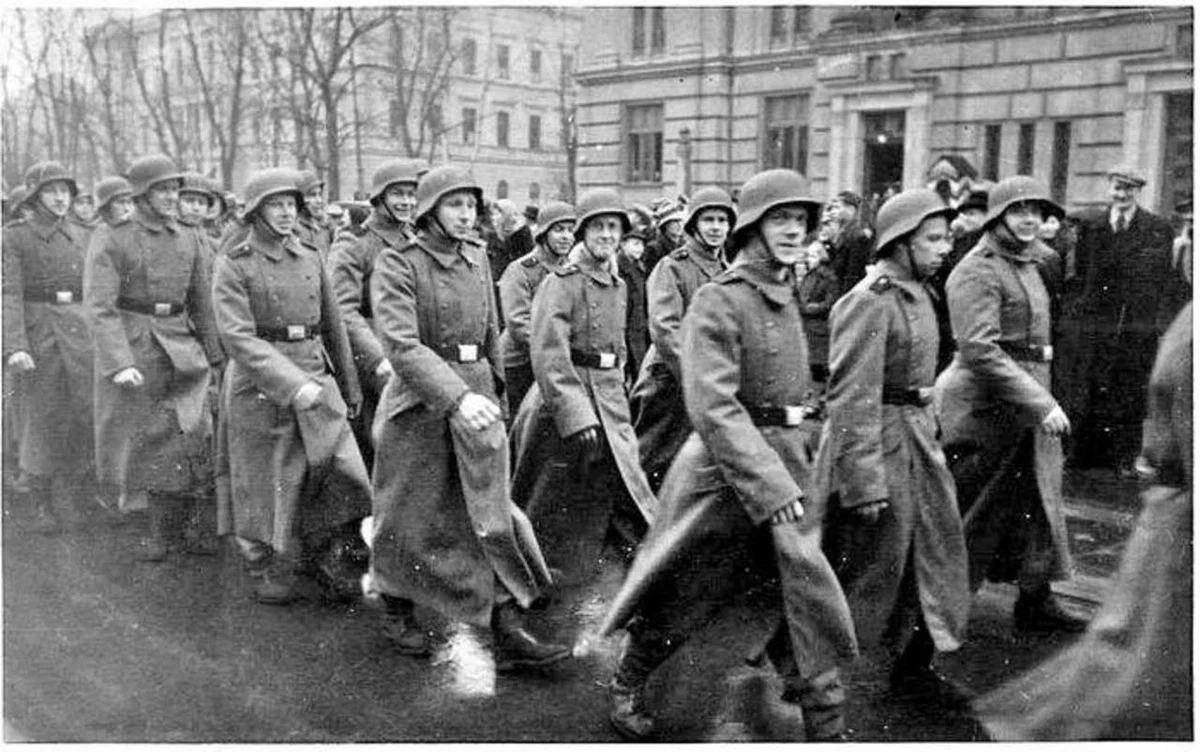 In January 1943, Hitler authorized the creation of the Latvian SS Legion. After the defeat of the German troops near Stalingrad on February 10, Hitler signed an order to form the Latvian SS Volunteer Legion. It included part of the Latvian volunteer units, created earlier and already taking part in the hostilities. In 1943, the 15th Waffengrenadier Division of the SS was created, and in 1944, the 19th Waffengrenadier Division of the SS.
In January 1943, Hitler authorized the creation of the Latvian SS Legion. After the defeat of the German troops near Stalingrad on February 10, Hitler signed an order to form the Latvian SS Volunteer Legion. It included part of the Latvian volunteer units, created earlier and already taking part in the hostilities. In 1943, the 15th Waffengrenadier Division of the SS was created, and in 1944, the 19th Waffengrenadier Division of the SS.
Despite the fact that it was formally announced that the legion was being created on a voluntary basis (its name contained the word German Freiwilligen – “volunteer”), in fact, the formation of the legion was carried out mainly in the order of forced mobilization of the male population of certain ages. Voluntarily went to serve about 15% of those called.
First call wave
On February 23, 1943, the General Commissioner of Latvia, Otto-Heinrich Drexler, issued an order to call up men born in 1919-1924 for military service. From the very beginning, the call was carried out on behalf of the Waffen-SS.
For mobilization in Riga, a replenishment department (SS-Ersatz Kommando Ostland) was created. According to the testimony of an employee of one of the draft commissions Boris Infantiev, people of various nationalities, except for Russians, gypsies and Poles, were at least 168 cm tall in the first wave of conscription.
All “voluntariness” consisted in the fact that after examination by a medical commission, the mobilized were given the right to choose a place of service: either in the Latvian SS legion, or in the service staff of the German troops, or in defense work. Compared with the latter, the legionnaires enjoyed the best food and material support, which led to the fact that the majority expressed a desire to go to the legion. Those who entered were promptly asked to sign that they were doing it voluntarily.
Initially, the conscription was regulated by the German occupation rules on the performance of labor service in the occupied eastern regions (Arbeitsdienst ), established by order of the Reichskommissariat “Ostland” of December 17, 1941. Later they began to refer to the Latvian law on general military service. Those employed in factories fulfilling the orders of the German army and working in paramilitary institutions (police) were exempted from conscription.
On March 23, 1943, the following message was published in the newspaper “Kauener Zeitung” :
By decree of HITLER, on February 27, the formation of the Latvian Legion began, as a closed combat formation in the ranks of the SS troops. Formation is basically completed. General BANGERSKY was appointed to the post of commander of the legion with the simultaneous assignment of the rank of major general and brigadeführer to him. General BANGERSKY, as well as his chief of staff, promoted to the Legion’s Standartfuehrer, Colonel SILGAILIS, took a solemn oath.
The legion was commanded by the German General Christian Hansen, while the Latvian Rudolf of Banger was appointed Inspector General.
On March 24, Reichsführer SS Heinrich Himmler issued an order clarifying the concept of “Latvian Legion” as a general designation for all Latvians, including those who had already served in the Latvian military formations, including police battalions.
On March 28 in Riga, each legionnaire swore an oath to Adolf Hitler :
In the name of God, I solemnly promise in the fight against the Bolsheviks unlimited obedience to the Commander-in-Chief of the Armed Forces of Germany, Adolf Hitler, and for this promise, as a brave warrior, I am always ready to give my life.
After that, in April 1943, registration of the male population of seven more ages, from 1912 to 1918, was carried out in Latvia, also subject to mobilization into the Latvian Legion. But soon this was not enough. Already in May, the mobilization of men began to be carried out, starting from the year of birth in 1899, and all the fighters of volunteer detachments to combat partisans began to be enrolled in the legion. Points for the formation of the legion were organized in most county towns of Latvia.
As a result, in May 1943, on the basis of six Latvian police battalions (16th, 18th, 19th, 21st, 24th and 26th), operating as part of Army Group North, the Latvian SS Volunteer Brigade was organized as part of the 1st and 2nd Latvian volunteer regiments. At the same time, volunteers of ten ages (born 1914-1924) were recruited for the 15th Latvian SS Volunteer Division, three regiments of which (3rd, 4th and 5th Latvian volunteers) were formed by mid-June.
Second wave of summoning
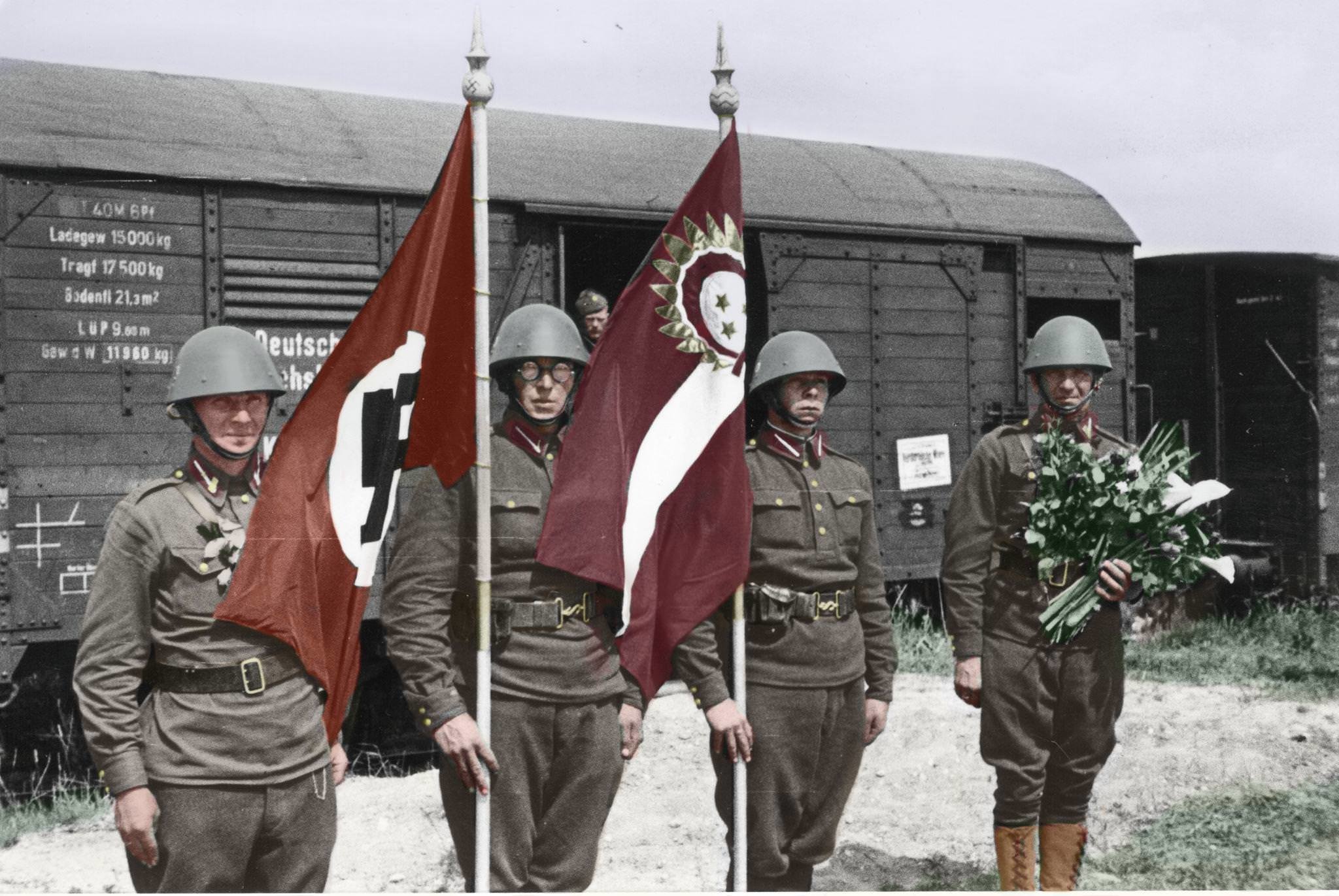 Volunteering was no longer mentioned in the summonses sent out in the mobilized summer of 1943, but the summons itself served as the basis for terminating labor relations with the employer, free travel to the draft board, and ordering the material support of the conscript’s family.
Volunteering was no longer mentioned in the summonses sent out in the mobilized summer of 1943, but the summons itself served as the basis for terminating labor relations with the employer, free travel to the draft board, and ordering the material support of the conscript’s family.
“Without any explanations, declarations, announcements, call-up papers began to be sent to everyone without distinction of nationality, of course, to those Latvians who, for one reason or another, had not yet been mobilized,” Infantiev recalls, also referring to numerous memoirs of other eyewitnesses of the events.
However, the mood of the mobilized was unstable. There were facts of evasion from mobilization and even desertion from the legion. In the report of the NKGB to the First Secretary of the Central Committee of the Communist Party of Latvia J. Kalnberzin dated July 24, 1943, it was reported that out of 500 people mobilized in four Latgale counties, 100 people had fled to the place of formation before being sent to the place of formation. Many hid in the forests. In the city of Zilupe, the mobilized sang Soviet songs; in the city of Ludza, there was a clash between the mobilized and the police.
Third wave of summoning
By the autumn of 1943, all men of a certain age were already subject to conscription, but a rather massive evasion from appearing at the draft commissions began. “Let those who have a dream of a homeland really so great that they are ready to sacrifice their lives fight,” the mobilized said, hiding from service.
To counter these sentiments, further conscription was carried out on behalf of the local inspector of the Legion, General Bangersky, the subpoenas made an indication of responsibility for draft evasion.
November 18, 1943 :
In the face of the burgomasters of all Latvian cities gathered in Riga, General Bangersky announced the mobilization of the Latvians liable for military service as the first step towards restoring the state independence of Latvia, emphasizing in his speech that without the successful defense of Latvia from the Red Army, Latvians will never have either a Latvian army or a free Latvian state.
The German occupation authorities resorted in December 1943 to the mobilization of the male population born in 1918-1922. Since these were already quite adults, some of them held senior positions both in the administration and in production, their turnout at the draft board dropped sharply. According to B. Infantiev, the fact that those who had already evaded the draft found new ways to get around it also played a role. A. Silgailis testifies that at the second and third commissions, the failure to appear was 32.5% – 6645 people.
In February 1944, the Soviet offensive was stopped, but the threat of its resumption remained, which forced the occupation authorities and the local Latvian self-government to intensify mobilization measures. The draft age was raised to 37 years, and only persons employed in the military industry and unfit for health reasons were still exempt from conscription. For the training of conscripts on the basis of the reserve training battalion of the 15th division, the 15th reserve training brigade of three regiments was deployed.
Ways to avoid mobilization
In view of the fact that skilled workers and managers began to fall under the draft, the General Directorate issued an instruction that allowed only the general directors of departments to make decisions on exemption from draft due to indispensability – UK (“Unabkommlichkeitskarte”). The petitions of church bishops for the release of seminarians were also ignored, since it was believed that they were only preparing for ordination to the dignity.
Corruption flourished in the issuance of the Criminal Code, according to the memoirs of legionnaires: release for a year cost a thousand marks, for a year – five thousand. “If you give cigarettes, vodka, speck or oil, then the results are even more reliable,” wrote J. Zarinsh. Initially, bribery was carried out directly through the draft boards and the Labor Department (Arbeitsamt), then the scheme became more complicated.
Traditional techniques that gained popularity among Latvians during the First World War were also used. Heinrich Krekenthals writes about this: “Some [conscripts] tried to evade conscription into the army. The rich paid off, say, with a pig, others hid, others smoked silk so that spots would be visible in the lungs when viewed on an x-ray”.
Boris Infantiev pointed to another channel for exemption from mobilization: sending a conscript to a production facility that fulfills military orders (repair of equipment, and so on) and therefore is considered part of the military machine. Infantiev personally managed to save four people from service in the legion by agreeing on their employment at the Daimler-Benz company through a good German friend who served in this company in Riga. These acts of sabotage were not disclosed.
Completion of formation
The punishment for failure to comply with the mobilization order was the death penalty. Fragment of the report of the Chief of the Main Directorate of the SS G. Berger to the Reichsführer SS G. Himmler dated June 13, 1944. “First negotiations with SS Gruppenfuehrer Bangerskis. An agreement was reached that the action for the new call must be well prepared, and in cases of desertion and non-appearance, respond very strictly, the deserters should be arrested and shot within 48 hours”.
In June 1944, the name “volunteer” (German: Freiwilligen)was changed to “Waffen”. Accordingly, the full name of the 15th division now sounded like this: (German 15 Waffen-Grenadier-Division der SS (lettische Nr. 1) ).
Due to the replenishment received by mobilization, it was possible to increase the strength of the Latvian SS brigade and deploy it into a division. Thus, the legion included two divisions: the 15th SS Grenadier Division (1st Latvian) and the 19th SS Grenadier Division (2nd Latvian). Their number as of June 30, 1944 was: 15th – 18,412 soldiers and officers, 19th – 10,592.
Compound
The legion was built on the model of the formations of the German army, the highest command staff consisted mainly of German officers, the middle command posts in the legion were occupied by former officers of the Latvian army, the legionnaires were armed with German, Czech and Romanian weapons, uniforms partly belonged to the former Latvian army, partly to the SS troops. Commands were given in Latvian.
- 15th SS Grenadier Division (1st Latvian):
- 32, 33 and 34 regiments;
- 19th SS Grenadier Division (2nd Latvian):
Latvian SS – Combat Record
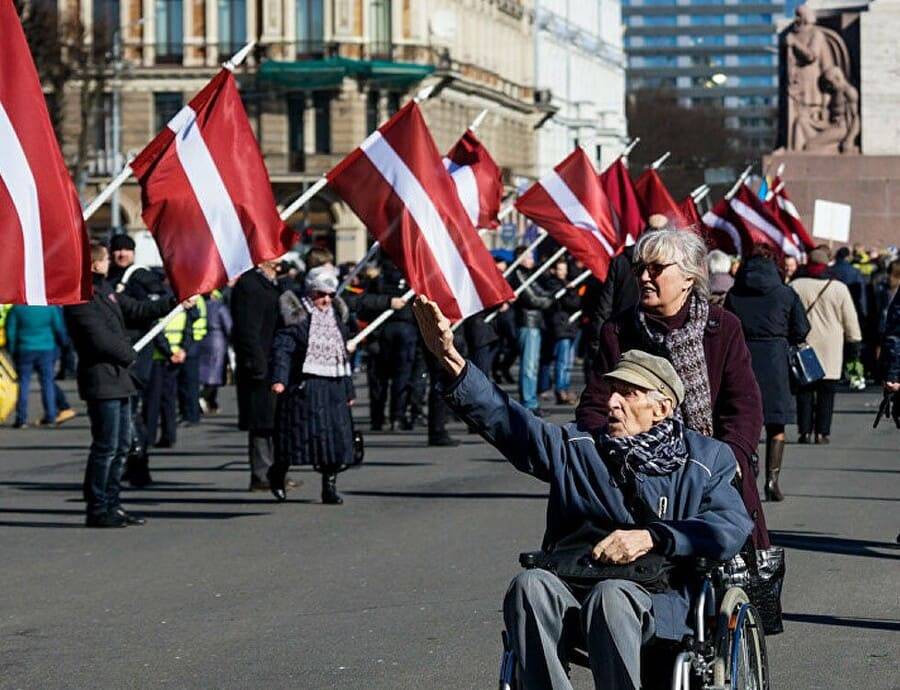 For the first time, the Latvian divisions jointly participated in combat operations against the advancing Soviet troops on March 16, 1944. This happened in the region of the Velikaya River, southeast of the city of Ostrov (Pskov region). Both divisions became part of the 6th SS Corps, which was subordinate to the 18th Army (Army Group North). Since 1952 this date has been celebrated by the “Daugavas Vanagi” organization as the Day of Remembrance of the Latvian Legionnaires.
For the first time, the Latvian divisions jointly participated in combat operations against the advancing Soviet troops on March 16, 1944. This happened in the region of the Velikaya River, southeast of the city of Ostrov (Pskov region). Both divisions became part of the 6th SS Corps, which was subordinate to the 18th Army (Army Group North). Since 1952 this date has been celebrated by the “Daugavas Vanagi” organization as the Day of Remembrance of the Latvian Legionnaires.
The German group, which included the 15th and 19th Latvian SS divisions, ended up in the Courland Cauldron. The 19th Division continued to fight there even after the surrender of the Germans in Berlin. In 1946, the legionnaires who left Latvia were extradited by Sweden back to the USSR.
The 15th division was transferred to Prussia in the fall of 1944. In April 1945, after fighting in West Prussia, the remnants of the 15th Division were re-formed and reinforced to 8,000 men at Mecklenburg. In April 1945, she took part in the battles for Neubrandenburg and later surrendered to American troops. And the reconnaissance battalion of the 15th division at the end of April 1945 was transferred to Berlin, where he participated in the last battles for the capital of the Third Reich. On May 3, 1945, the last fighters of the reconnaissance battalion left their positions in the Ministry of Aviation. Before that, they left the Reichstag as the last part that defended it.
Of the 115 thousand soldiers and officers of the legion, over 40 thousand died and almost 50 thousand were captured by the Soviets.
Legion war crimes
Headquarters officer of the ROA lieutenant V. Baltinsh.
report dated May 26, 1944 to Colonel V. Pozdnyakov*.
… < >… On April 23, 1944, I had to be in the village of Morochkovo. All of it was burned. SS men lived in the cellars of the huts. On the day of my arrival there, they were supposed to be replaced by a German unit, but I still managed to speak in Latvian with several SS men, whose names I do not know. I asked one of them why the corpses of murdered women, old people and children, hundreds of unburied corpses, as well as dead horses, lie around the village. A strong putrid odor hung in the air. The answer was: “We killed them in order to destroy as many Russians as possible.”
After that, the SS sergeant led me to the burnt hut. There were also several charred, half-buried bodies. “And these,” he said, “we burned alive”…
When this Latvian part left, she took with her several Russian women and girls as concubines. They were charged with washing clothes for soldiers, heating bathhouses, cleaning rooms, etc.
After the departure of this part of no more than a company unit, with the help of several more people, I dug up the straw and ashes in the burnt hut and removed half-burned corpses from there. There were 7 of them, all were female, and all of them had a wire tied to their leg, nailed to the door jamb with the other end. We removed the wire from the numb, burnt legs, dug seven graves and buried the unfortunate, reading “Our Father” and singing “Eternal Memory”.
… < > … I don’t remember the name of the village where a cloud of flies circling over a wooden barrel caught my attention. Looking into the barrel, I saw severed male heads in it. Some had mustaches and beards. Around the village we found many corpses of executed peasants. After talking with the surviving residents, we had no doubt that the Latvian SS also operated here, which showed their courage and fearlessness in reprisals against the defenseless population.
Everything else they do seems insignificant compared to that terrible barrel and the women burned alive in the hut.
… < >…Unfortunately, I do not know the names or numbers of the units involved in the atrocities.
* Colonel V. Pozdnyakov – former adjutant A.A. Vlasov, sent to Riga by the propaganda department of the Wehrmacht
The 19th Latvian SS division was directly involved in punitive actions against Soviet citizens in the territories of the Leningrad and Novgorod regions.
Punitive actions
In 1943, parts of the division took part in punitive operations against Soviet partisans in the areas of the cities of Nevel, Opochka and Pskov (560 people were shot by them 3 km from Pskov).
On December 18, 1943, a gendarmerie company of the 19th Latvian SS division shot about 250 civilians in the village of Zalya Gora, west of Novgorod. In early January 1944, the company took part in mass executions in the city of Chudovo, Leningrad Region. On January 21, in the village of Glukhaya, about 200 people were locked in a barn and machine-gunned. In total, from December 18, 1943 to April 2, 1944, units of the 19th Latvian SS division participated in punitive actions, during which 23 villages were destroyed (up to 1300 people were shot in 13 of them).
Forced deportation of civilians
In March-April 1944, when occupying a position southeast of the city of Ostrov, on the arc of the Velikaya River, the 19th division burned to the ground all the villages along a 12-kilometer front, and the civilian population was driven to the rear of Latvia. About 2,000 houses were destroyed in this way, Valery Kirshtein, assistant chief of infantry of the 19th Latvian Waffen-SS Grenadier Division, showed. He also testified that during the retreat of the division from Opochka, on the orders of its commander, Lieutenant General Bruno Streckenbach, a forcible hijacking of the population was organized in the direction of Liepaja. Thus, the forces of the division stole 60 thousand civilians, mostly women and children, their property was looted, and livestockrequisitioned by the military, fodder burned. People were allowed to take on the road only the essentials.
POW killing
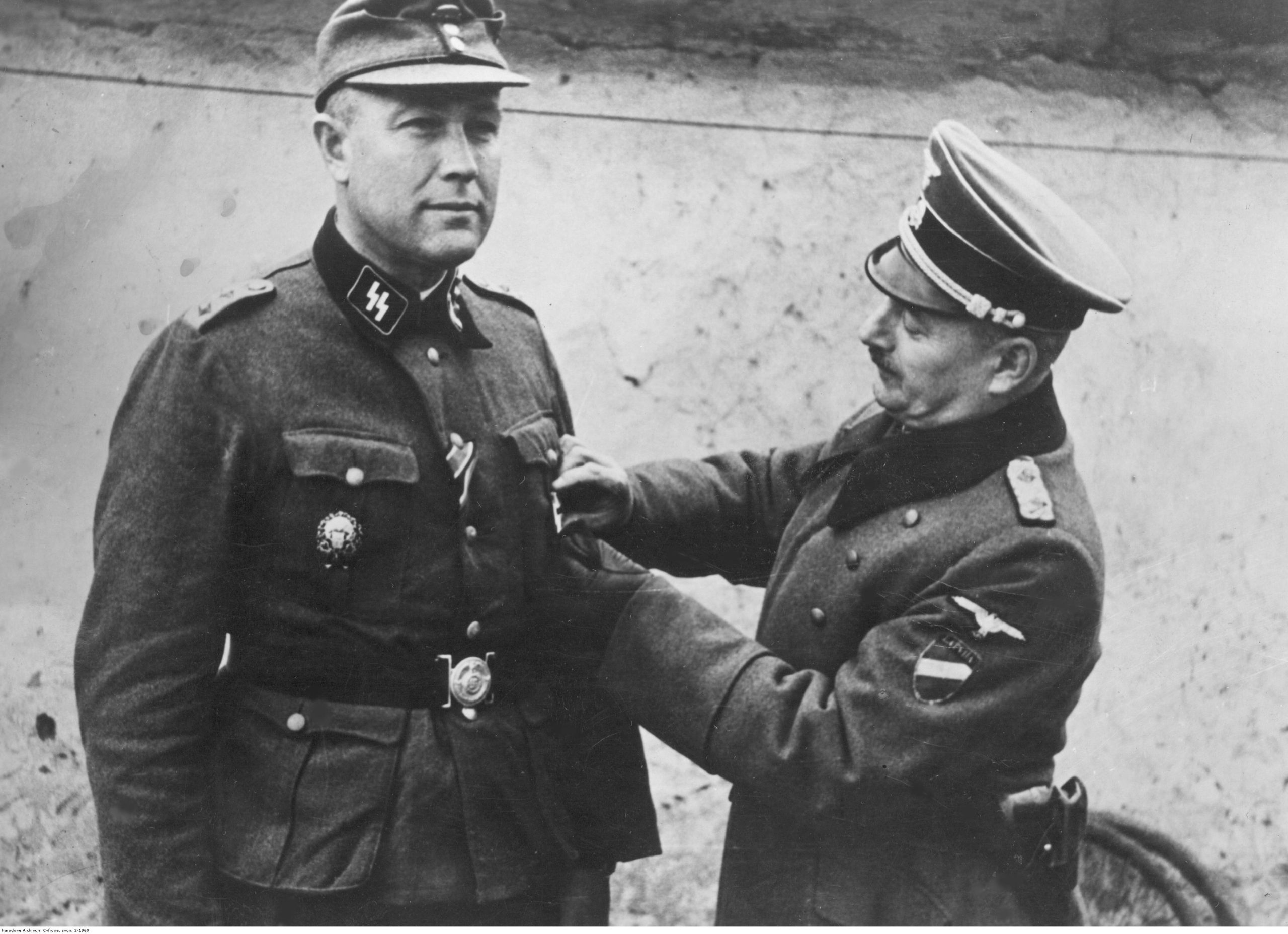 The servicemen of the Latvian SS divisions also participated in the brutal murders of captured Soviet soldiers, including women.
The servicemen of the Latvian SS divisions also participated in the brutal murders of captured Soviet soldiers, including women.
In particular, on August 6, 1944, 15 prisoners of war from the 65th Guards Rifle Regiment of the 22nd Guards Rifle Division, captured near the village of Bobryni (Latvian SSR), were tortured to death by the personnel of the 43rd Rifle Regiment of the 19th Latvian SS Division. Here are the lines from the special message of the head of the SMERSH counterintelligence department of the 2nd Baltic Front dated August 18, 1944 “On the abuse of Soviet prisoners of war by the Germans and their accomplices from the Latvian SS units” :
On the night of August 6 this year. The 65th Guards Rifle Regiment of the 22nd Guards Rifle Division in the area of the village of Bobryni (Latvian SSR) carried out an offensive operation. The Germans and Latvians from the SS division bypassed the battle formations of the guards, attacked them from the rear and cut off a small group of Soviet soldiers and officers from their units. During the battle, 43 soldiers and commanders were wounded, who, due to the difficult situation, could not be evacuated. Having captured the prisoners, the German scoundrels staged a bloody massacre over them. Private Karaulov N.K., junior sergeant Korsakov Ya.P. and guard lieutenant Bogdanov E.R., the Germans and traitors from the Latvian SS units gouged out their eyes and inflicted many stab wounds. Guard Lieutenants Kaganovich and Kosmin, they carved stars on their foreheads, twisted their legs and knocked out their teeth with boots. Medical instructor Sukhanova A.A. and three other nurses had their breasts cut out, their legs and arms twisted, and many stab wounds were inflicted. Soldiers Egorov F. E., Satybatynov, Antonenko A. N., Plotnikov P. and foreman Afanasyev were brutally tortured. None of the wounded, captured by the Germans and the Latvian fascists, escaped torture and painful abuse. According to reports, the brutal massacre of wounded Soviet soldiers and officers was carried out by soldiers and officers one of the battalions of the 43rd Infantry Regiment of the 19th Latvian SS Division.
This fact confirms the provision of the judgment of the Nuremberg Tribunal, establishing that
… there is evidence that the execution of unarmed prisoners of war was common in some SS divisions…
This directly concerns the Latvian divisions, in which prisoners were destroyed in more brutal ways.
Crimes in Poland
Tragedy in Podgaia
At least one crime was committed by soldiers of the Latvian SS Volunteer Legion during the period when their unit was part of the Elster battle group (German: Kampfgruppe Elster).
On the night of January 29, 1945, fighters of the 1st Army of the Polish Army crossed the pre-war Polish-German border, took the city of Zlotow and reached the Gwda River, beyond which stretched the defensive strip of the Pomeranian Val. January 31 1st Polish Infantry Division. T. Kosciuszko (1st Army) began heavy fighting for the village of Podgae (then Flederborn) – the point of strong resistance of the Nazis.
In order to inspect the defense system and enemy forces in the Podgae region and, under favorable conditions, occupy and hold the village until the main forces approach, the 4th company of Lieutenant Alfred Sofka set off at about two in the afternoon, together with support forces numbering about 80 people. The detachment stumbled upon the superior forces of the Nazis from the 15th Latvian SS Volunteer Division, which is part of the Elster battle group (Kampfgruppe Elster). The Poles were surrounded, but continued to fight throughout the day (about 2 hours), until they ran out of ammunition and dressings. Losses amounted to 50%. The Poles were forced to surrender (this decision was made by Lieutenant Sofka). 37 soldiers were taken prisoner.
The Latvian legionnaires did not take the seriously wounded prisoners, killing them on the spot. The rest of the prisoners were brought to Podgay, locked in a barn and, as expected, handed over to the Germans. During interrogations, the Poles were tortured, and they decided to flee, but their escape failed. The Nazis caught almost everyone, with the exception of three killed, including the company commander, as well as Lieutenant Zbigniew Frugala and Corporal Bondzelevsky, who managed to escape (hide in the forest )(the first after the war remained in the army and rose to the rank colonel, and the second was killed during the battles for Berlin ). The remaining captured Polish fighters – 32 people – were tied by the Germans with barbed wire, doused with gasoline and burned alive. in a closed barn. The oldest of the soldiers – Private Felix Buevich – was 48 years old. The youngest, Private Julian Wozniak, was not yet 20. Most of the dead soldiers were only a few years older than him.
According to Joseph Koren, eyewitnesses – local residents – said that the soldiers of the Latvian SS legion sang and danced around the barn during the burning of the Poles alive. The crime of the Latvian legionnaires became known three days later, when the village was recaptured and liberated by Polish troops, who discovered the remains of 32 of their burnt comrades.
The general public learned about the events in Podhai thanks to the film “Elegy” (Polish)
(1979) directed by Pavel Komorowski.
In 2011, a study by Jurgen Fritz and Edward Anders (USA) was published, which questions the course of events in Podgaj as described in Polish sources. In particular, it is alleged that the Latvian units could not participate in the capture of Sofka’s company, since they arrived in Podgai only on the evening of January 31, and the battle took place during the day. It is also concluded that the burning alive of Polish prisoners of war is unlikely. At the same time, the opinion is expressed that the total number of Polish prisoners shot could reach 160-210, and the executions were most likely carried out by the German SS units, which, together with the Latvian and Dutch units, took part in the defense of the village.
In 2002, a monument was erected at the site of the tragedy, symbolizing the flame of a burning barn. On the obelisk is the coat of arms of the 1st Infantry Division of the Polish Army. Tadeusz Kosciuszko and the names, ranks and dates of birth of the dead Polish prisoners of war. On the stand there is an inscription: “On February 2, 1945, the Nazis burned alive in the barn standing on this place 32 soldiers of the 3rd Infantry Regiment of the 1st Infantry Division named after Tadeusz Kosciuszko, who fought for the return of the Piast lands to the Motherland”.
Crimes in Belarus
Historian Sergei Kudryashov claims that in February and March 1944, the Latvian SS legionnaires destroyed 138 villages in the Vitebsk region of Belarus, killed 17 thousand people and drove another 13 thousand to Germany. His publication was based on materials from recent Russian sources.
In the report of the officer of the ROA lieutenant Baltinsh, one of the legionnaires is quoted as saying “We killed them in order to destroy as many Russians as possible!”
At the beginning of May (1944), near the village of Kobyliniki, in one of the hollows, we saw about three thousand bodies of executed peasants, mostly women and children. The surviving residents said that the executions were carried out by “people who understood Russian, wore skulls on their caps and red-white-red flags on their left sleeves” – the Latvian SS.
Opinions
Opinion of Latvian historians
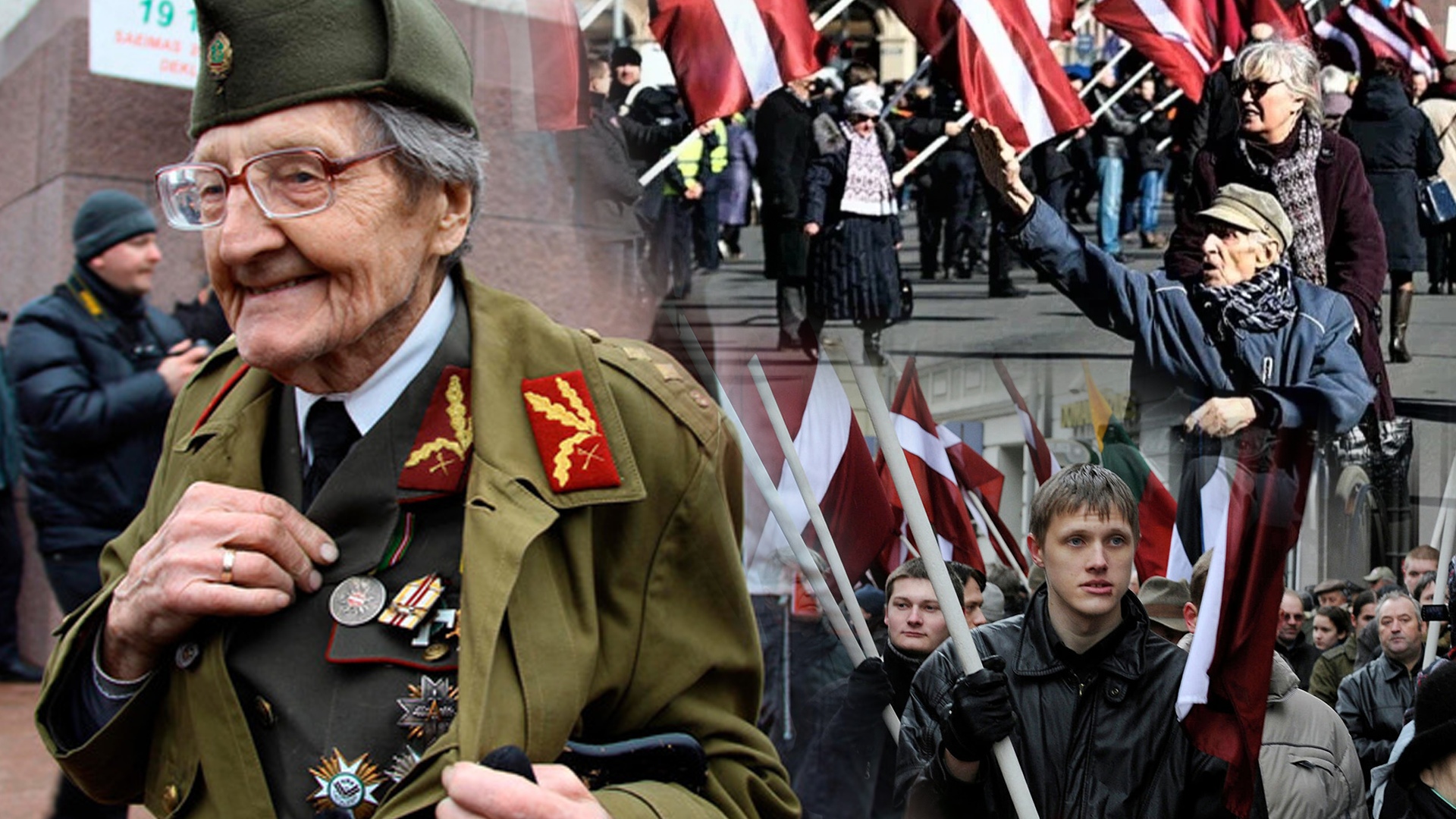 According to the surviving documents, memoirs of war veterans and media publications, it would hardly have been possible to create a legion if Latvia had not been annexed by the Soviet Union in 1940. According to the statements of the Ministry of Foreign Affairs of Latvia, the first year of the Soviet occupation was terrible for them and caused in the Latvian society, hitherto positively disposed towards Soviet Russia, deep hostility towards the USSR. The mood of the soldiers in the context of these events was described in his message by a German officer, commander of the 15th division, Oberführer A. Aks. On January 27, 1945, he wrote :
According to the surviving documents, memoirs of war veterans and media publications, it would hardly have been possible to create a legion if Latvia had not been annexed by the Soviet Union in 1940. According to the statements of the Ministry of Foreign Affairs of Latvia, the first year of the Soviet occupation was terrible for them and caused in the Latvian society, hitherto positively disposed towards Soviet Russia, deep hostility towards the USSR. The mood of the soldiers in the context of these events was described in his message by a German officer, commander of the 15th division, Oberführer A. Aks. On January 27, 1945, he wrote :
First of all, they are Latvians! They want an independent Latvian nation-state. Faced with a choice: Germany or Russia, they chose Germany because they seek cooperation with the civilization of the West. They see German rule as the lesser evil. The hatred for Russia has been deepened by the occupation of Latvia… They regard the fight against Russia as their national duty.
Many Latvians viewed the legion as the core of the future national army and directly linked participation in the war against the USSR with the struggle to restore Latvia’s independence. The views and moods of the legionnaires are clearly seen in their letters to their relatives. As evidenced by the surviving report of the postal censor of the 15th division, in the letters of soldiers the idea is most often expressed that in order to fight, next to the “negative goal” – protection against Bolshevism – there must also be a “positive goal” – the autonomy of Latvia. However, in the summer of 1944, with the approach of the front to the borders of Latvia, this requirement faded into the background, since the main concern for the SS legionnaires was the direct threat to their homeland from the Soviet troops..
In fact, other documents testify to the same. Here is a fragment of the message of the Chief of the Security Police and the Security Service of Latvia, SS Obersturmbannführer R. Lange, dated August 1, 1943 :
… It has been noticed that the servicemen of the Latvian brigade who are at the front, due to general front-line events, are in favor of cooperation with the Germans, however, in the Latvian armed units that are trained at home, clearly nationalist sentiments and rejection of everything German are increasingly noted. The officer corps is obviously in the ranks of the growing chauvinist influence. This is expressed in indiscipline and hostility towards the Germans in military units…
Other opinions
No one has ever said that a person who was in the Latvian SS legion should be held accountable for this. It is not true. We know that the Latvian SS legion was created in March 1943, when almost all the Jews had already been killed, but the truth is that some of the people who were members of the SS legion were previously involved in crimes against Jews. When we say that we want to call these people to account and judge, it is because of the crimes that they committed in 1941 and 1942, and not because they were in the SS legion.Director of the Jerusalem Office of the Simon Wiesenthal Center E. Zuroff in an interview with the program “Vakara intervija”.
If it suits you that they masquerade as independence fighters, then I think you do not understand the essence of things. The truth is that people had to make a difficult decision. But if you chose the wrong side, if you supported a regime that killed tens of millions of people, then don’t think that you are heroes…. The saddest thing I saw today was during the procession of young people who walked with the flags of modern, democratic Latvia to pay respect to these people. This creates the impression that people in Latvia who fought for Nazi Germany are supported. And if someone supports it, then he took the wrong side.Director of the Jerusalem Bureau of the Simon Wiesenthal Center E. Zuroff
about the events in Riga on March 16, 2010, dedicated to the memory of the soldiers of the Latvian SS Legion
There is an opinion in the scientific community that the Latvian SS Legion has signs of a criminal organization noted by the Nuremberg Tribunal: the procedure for mobilizing conscripts to the Legion was not exclusively coercive, members of the Legion were aware of the criminal nature of the SS organization and, thus, were involved in the commission of crimes against humanity.
Post-war period
Captivity and liberation in the West and in the USSR
About 30 thousand Latvian soldiers became prisoners of war of the Western Allies, surrendering to them after the surrender of Germany. In December 1945, Latvian prisoners of war in a camp in Belgium formed the Daugava Hawks organization. The Latvian organizations succeeded in persuading the Allies that the Latvian legionnaires should be treated as citizens of an independent Latvia, illegally conscripted into military service, so they were soon released from POW camps and later received permission to emigrate to the UK, the US and other Western countries. Many of them served as workers and assistant security guards in the armed forces of the United States and Great Britain, stationed in Germany. Already at the Nuremberg Trialsrecent comrades in arms guarded Nazi criminals.
A small group of Latvian legionnaires was extradited to the Soviet Union by Sweden.
Legionnaires taken prisoner by the Red Army, according to the Decree of the GOKO of August 18, 1945 No. 9871s and the Decree of the Council of People’s Commissars of the USSR of December 21, 1945 No. 3141-950ss, were sent to resettle in the northern regions of the USSR for a period of 6 years along with the “Vlasovites” and other collaborators. However, already on March 16, 1946, the first secretary of the Communist Party of Latvia, J. Kalnberzin, and the head of government, V. Latsis, sent a letter to the deputy chairman of the Soviet government, V. M. Molotov, in which they repeated the thesis about forced mobilization into the Legion and that their compatriots evaded it in every possible way, and therefore, with their condemnation after the war, “a large number of families of citizens of the Latvian SSR lost their breadwinners. On this basis, the remaining relatives, who, for the most part, are old people, women and children, developed a depressed mood, which manifested itself with all its acuteness at all pre-election meetings during the election campaign to the Supreme Council and still continues to greatly excite the remaining numerous relatives. Considering that the sending of former legionnaires into the interior of the country caused negative sentiments among the population of Latvia, and taking into account that the Latvian SSR is in great need of labor… what is the so-called. legionnaires in the German army were mobilized by force,.
The government of the USSR responded to the request promptly: on April 13 of the same year, Resolution of the Council of Ministers No. 843-342ss “On the return of repatriates – Latvians, Estonians and Lithuanians” to their homeland was adopted. It provided that during 1946 the former legionnaires of the Latvian, Estonian and Lithuanian nationalities were to be released and returned to their homeland. The decree did not affect the employees of the legion of other nationalities.
Recent history
March 16 of each year is considered the Day of Remembrance of the Latvian Legionnaires. From 1998 to 1999. was official. On this day in Latvia (mainly in Riga and at the memorial cemetery in Lestene)solemn events are held where the relatives of the fallen legionnaires, caring people, veterans and national organizations take part.
- In 1992, an exposition about SS Standartenführer Plensner was opened in the military museum of the city of Riga. It was he who was subordinate to the Latvian Nazi formations, which, on his orders, killed many thousands of Jewish citizens in Latvia in the summer of 1941.
- On March 16, 1995, on Legionnaires’ Memorial Day, the remains of the former Inspector General of the Latvian SS Legion, General Rudolf Bangersky, brought from Germany, were buried at the Fraternal Cemetery in Riga.
- In 1997, a scandal erupted in the German media over the lists of survivors of Nazism submitted by the Latvian government in order to receive monetary compensation. Latvia added 10,000 SS veterans to the 120 prisoners of Nazi concentration camps.
- On March 16, 1998, for the first time in Riga, permission was obtained for an official procession of members of both Latvian SS divisions, in which the current (at that time) commander of the National Armed Forces of Latvia, Juris Dalbinsh, who called the “patriots and freedom fighters “(June 8 of the same year was dismissed due to poor health).
- On June 17, 1998, the Parliament of Latvia adopted a resolution on holidays and memorable dates, in which, among other things, the Day of Remembrance of Latvian Soldiers on March 16 was established.
- In 1998 in the town of Lestene (Latvian.)
- (Tukum region, Kurzeme)a memorial ensemble and fraternal cemetery of Latvian legionnaires was created, where the “Society of National Warriors” plans to continue the reburial of dead soldiers, reburying 5 thousand legionnaires on it, and create the second largest memorial fraternal cemetery in Lesten. As of 2014, about 1,100 soldiers were buried in the cemetery.
Nowadays, some political, public and religious figures of Latvia take part in the events of veterans of the Latvian SS Legion in Lestene. Including, among others, the Minister of Culture I. Ribena was noticed (Latvian.)
rus.
.
On September 27, 1998, a solemn ceremony of reburial of 10 soldiers of the Latvian Legion was held in Lestene, which, in particular, was attended by the commander of the Latvian militia Zemessardze (executive secretary of the Ministry of Defense for integration into NATO) R. Graube, as well as former Commander of the National Armed Forces of Latvia J. Dalbinsh. (etc. )
- On October 29, 1998, the Saeima of Latvia adopted the “Declaration on the Latvian Legionnaires of World War II”. According to comments and clarifications in the media, this document obliges the Latvian government to demand compensation from the occupying countries and their successors for damage caused by mobilization into the occupying armies, as well as to take care of eliminating encroachments on the honor and dignity of Latvian soldiers in Latvia and abroad. The Ministry of Foreign Affairs and the State Duma of Russia called this declaration “blatantly provocative.”
- In 2008, the executive director of Riga, Andris Grinbergs, rejected the application of the nationalist organization Union of National Strength (Latvian.)
- ”(NSS), according to which on March 16 it was planned to hold an annual procession in memory of the Latvian legionnaires. In this case, the ban on the procession was justified by the fact that the Union of National Forces organization had not been re-registered in the relevant institutions. At the same time, the official emphasized that he did not refuse the procession, but only demanded changes in the place and time of its holding.
Procession on the Day of Remembrance of the Latvian Legionnaires in Riga
Investigation on former legionnaires
On March 16, 2020, the Rossiya Segodnya MIA published a report “Accomplices of Nazi crimes. 96 veterans of the Latvian SS legion who are still alive”, which for the first time contains data on the biographies of the Legion volunteers who found asylum in the USA, Canada, Australia, Argentina, Brazil, Great Britain and were not punished, as well as those who live in Latvia after serving their sentences under Soviet law. Mikhail Chernov, chairman of the board of the Russian Fund for the Support and Development of Jewish Culture, Traditions, Education and Science, stressed that war crimes have no statute of limitations, and the people who committed them should be prosecuted as severely as possible in order to “discourage the desire to follow their ideas.” “Whether you are 90 or 100 years old, you must answer according to the law, or at least you must not keep a clean name. This information should be disseminated, the authorities and local communities of the countries where these people now live should know about it”.
In total, for 2020, about 400 former legionnaires lived in Latvia and abroad. In modern Latvia, they receive benefits from the state on an equal basis with other participants in the Second World War. Abroad, they are united in the organization “Daugava Hawks”, which receives the support of the Ministry of Foreign Affairs of the Republic of Lithuania. Some of the legion veterans have been awarded state orders of the Republic of Latvia.


